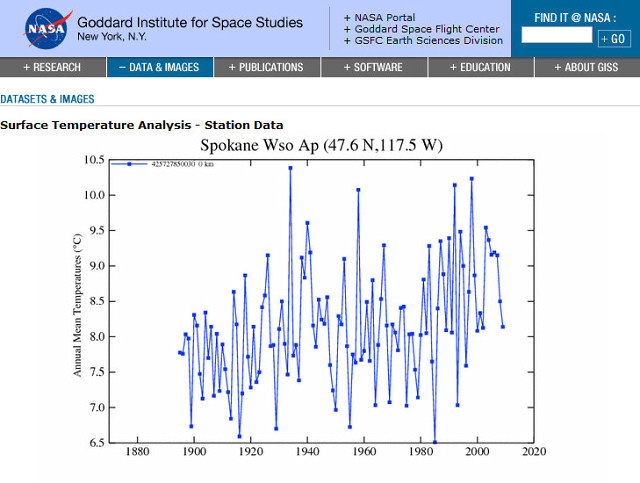Has Spokane Warmed?
December 14, 2009Contrarian 2 Comments »
One series of emails from the “Climategate” CRU email release which has drawn some attention is this one between Phil Jones of CRU et al and Swedish climate researcher Wibjorn Karlen. It concerns the temperature trends in the Nordic countries shown in IPCC AR4. Karlen asks Jones and Trenberth for the data upon which the IPCC graph is based, since the data from the official NORDKLIM climate data network shows no such trend.
That discrepancy has prompted a flurry of mini-investigations by bloggers and their commenters around the world into similar discrepancies involving temperatures in their local areas — which they are finding all over the place.
The discrepancies arise between the “raw” temperature data recorded by weather stations and the “adjusted” figures reported by the various agencies which collect and analyze them — primarily the Goddard Institute for Space Studies (GISS) in the US and the Climate Research Unit (CRU) in the UK. Both organizations obtain most of their land temperature data, however, from a single source — the Global Historical Climate Network (GHCN) which is operated by the National Climate Data Center (NCDC) at Arizona State University. NCDC is a branch of NOAA — although the manager of the GHCN appears to be an employee of NASA.
Not wanting to miss a ride on this bandwagon, I took a quick look at adjusted v. unadjusted temperature trends for GHCN stations in the Spokane area. This image shows all stations within 1 geographic degree of Spokane which have records back to at least 1910. Blue lines are unadjusted, red lines adjusted temps, per GHCN. The bottom right panel shows the Spokane temp trend reported by GISS.
You’ll notice that every one of the stations shows a downward adjustment for temperatures prior to 1965 or so (this “pivot point” varies somewhat from station to station). E.g., for Pullman, there is a downward adjustment of about 0.7C prior to 1954, then an upward adjustment of about 0.2C a couple years later. For Ritzville, temps before 1965 are adjusted downward about 0.6C. And so on.
Everyone agrees that some adjustments are necessary to compute long-term trends. That is because stations are moved, newer instruments replace older ones, the times of day when readings are taken change. For Spokane, for example, there is a large downward adjustment — about 0.8C — for temps earlier than 1946. This one is probably legitimate, as the official station was moved from downtown Spokane to Geiger Field. Then there was a smaller downward adjustment, about 0.1C, in 1979.
What is curious, though, is that these adjustments seem to disproportionately either raise recent temps or reduce older ones, thereby creating or enhancing a long-term upward trend not apparent in the raw data. You would expect the adjustments over all stations in the network to be rather random, with roughly equal numbers of upward and downward adjustments.
The data collaters — GISS and CRU — do their own adjustments. Notice the two bottom panels. The GHCN plot even after their adjustment shows no obvious trend. But the GISS plot sure does.
Anyone who wishes to check other areas can get the GHCN plots here, and the GISS versions here.


Posted on January 21st, 2010 at 1:46 pm
On the assumption that GISS is being 100% honest with their adjustments, there are still some issues.
– They need to do a much better job of explaining the adjustments, why they were made, algorithms used, etc. To date the explanations amount to, “Trust us.”
– A number of peer-reviewed papers show the Urban Heat Island effect to be real and significant. There is a serious question as to whether this is properly allowed for in any data set.
– SurfaceStations.org discusses some major issues with the quality of the land based temp record.
If you DON’T assume that the GISS (and others) are being 100% honest, then things get a lot more interesting.
And if you assume they’re corrupt, well…
Posted on January 21st, 2010 at 11:11 pm
Both GHCN and GISS obtain their adjustments from a statistical algorithm, not by examining station metadata. GHCN has been very forthcoming explaining their methodology, and acknowledges there are some problems with it (they are currently revising it). GISS’s method is murkier.
There are a number of methods for obtaining trends which don’t depend on statistical adjustments. Several people in the blogosphere are working on those. I expect to see a new 100 year trend based on these methods within the next couple of months.